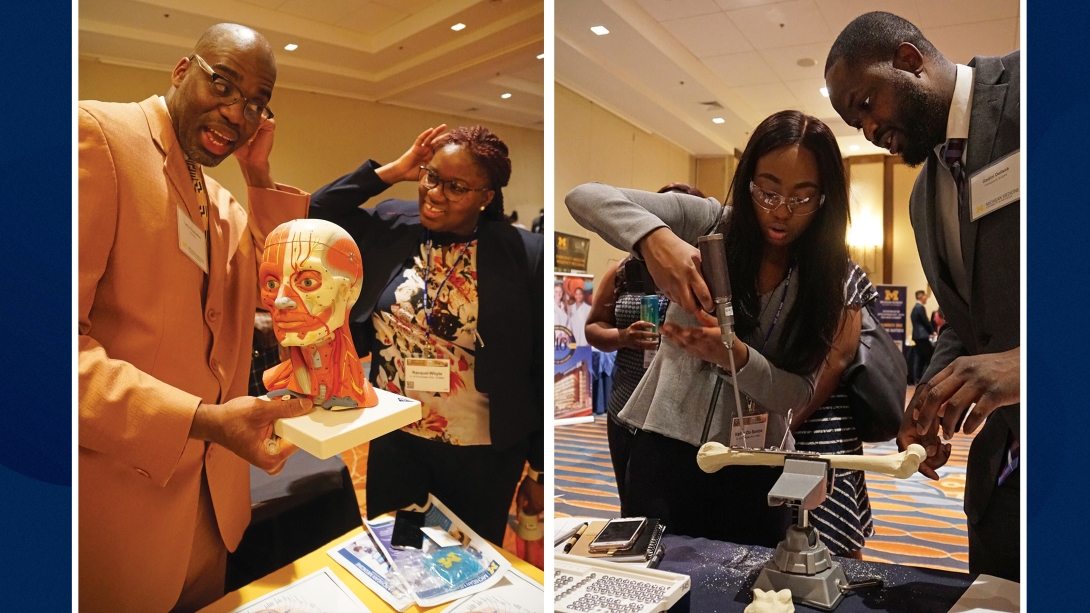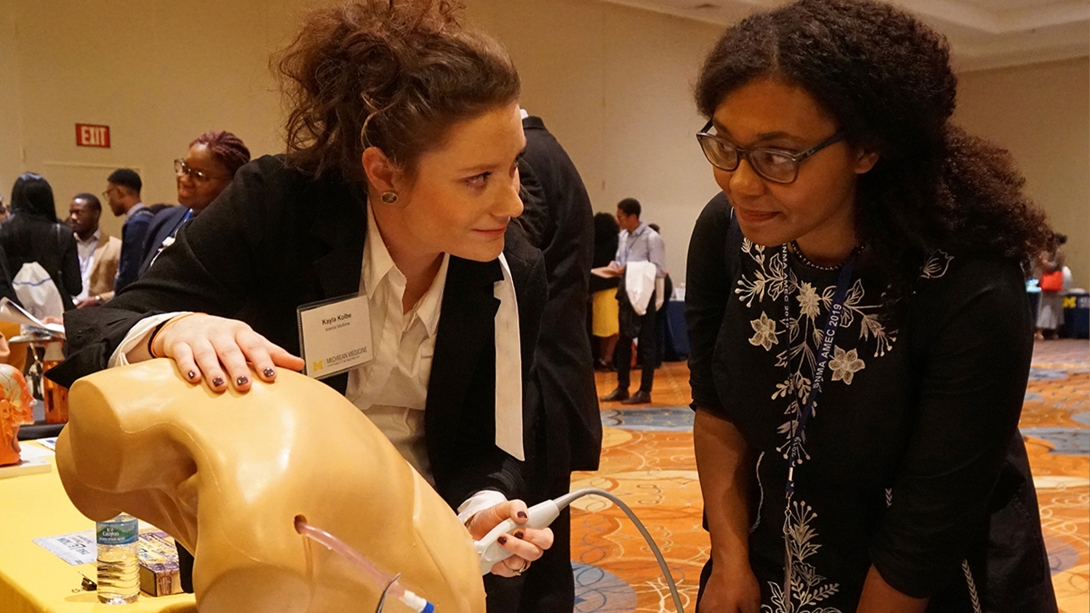The specialized event for historically marginalized and underrepresented medical students comes with ‘astounding’ results, a published survey finds
5:00 AM
Author |

According to the Student National Medical Association, their organization has been “committed to supporting current and future historically marginalized students” since 1964. Their goal is to ultimately address the needs of underserved communities, while increasing the number of underrepresented individuals within the field of medicine.
“Every year, the SNMA hosts the Annual Medical Education Conference, or AMEC, and since 2017, Michigan Medicine’s Office for Health Equity and Inclusion has organized a simulation festival for the students attending this conference,” said David J. Brown, M.D., who serves as the associate vice president and associate dean for health equity and inclusion at the University of Michigan Medical School.
The Michigan event, coined ‘SiMfest,’ includes interactive clinical stations and several hands-on experiences for AMEC students to partake in. Many departments from the hospital participate, bringing with them simulation equipment to lead prospective students through clinical simulations in their specialty areas.
“Over 40 Michigan Medicine chairs, faculty members, house officers and staff join in on SiMfest, and Michigan is the only school that organizes such an event, which in turn generates a lot of positive impressions about our academic medical center,” said Brown.
Brown says SiMfest provides students with an opportunity to envision themselves working at the medical center alongside faculty members and current house officers, which gives them a sense of the culture at the U-M Medical School.
A mission to improve diversity
The idea of SiMfest came to be after focus groups with several house officers underrepresented in medicine lacked feedback about diversity.
“We asked them [in the focus groups] why they chose to come to Michigan Medicine to continue their training. The unanimous response from each of them was because of the quality of training at Michigan Medicine and they emphasized our outstanding patient care. Response after response seemed to revolve around this theme, but very few mentioned the diversity within our residency training programs,” said Brown.
Brown felt they could organize a hands-on simulation event at SNMA that could demonstrate the school’s commitment to education and dedication to diversity.
Prior to participating, 18% of students reported interest in applying to our institution for the next phase of their medical training. However, nearly 66% of pre-medical students and 63% of medical students reported a strong interest in applying to the U-M Medical School upon participating in our event.”
- Marcia Perry, M.D.
The idea took off, with SiMfest now around since 2017.
Positive, and published, feedback
Brown and a team of colleagues from OHEI surveyed SiMfest participants and volunteers about their experiences with the event from 2017 to 2019. The medical students were asked to anonymously provide information regarding “the value of their clinical experience, area of clinical interest and willingness to apply for training at [the U-M Medical School].”
Their findings were recently published in the Journal of the National Medical Association.
“We were able to gather data from 461 student participants and 83% of those surveyed indicated that they are from a racial category considered historically marginalized,” said Marcia Perry, M.D., who is a co-author of the paper and currently serves as the director of house officer programs within OHEI. “And of those individuals, 91% identified as African American or Black.

Perry adds that an overwhelming 80% of the student participants rated their experience at SiMfest favorably and said they would recommend it to their peers. In addition, 73% of the pre-medical students and 54% of the medical students surveyed “reported being exposed to a specialty” in which they weren’t previously familiar with.
SEE ALSO: Medical student tackles cystic fibrosis on a global scale | Michigan Medicine
“Prior to participating in SiMfest, a meager 18% of students reported interest in applying to our institution for the next phase of their medical training,” said Perry. “However, nearly 66% of pre-medical students and 63% of medical students reported a strong interest in applying to the U-M Medical School upon participating in our event. This was pretty astounding to see.”
Brown notes that their findings were not exclusive to their student participants, as clinical departmental volunteers were also surveyed about their experiences at SiMfest.
SEE ALSO: Diversifying medicine (michiganmedicine.org)
“We found that SiMfest inspired many of them – 66% – to pursue other initiatives focused on diversity, equity and inclusion within their own departments,” he said. “This experience broadened the exposure of our chairs and faculty to a large cohort of bright, talented, and diverse future physicians.”
According to Perry, half of the departmental representatives surveyed felt that SiMfest “enhanced awareness and engagement [around] diversity, equity and inclusion initiatives among [Michigan Medicine’s] leadership,” and 72% reported that the event should continue, as they felt it was worth their time and efforts.
“The entirety of SiMfest is so important because its benefits are twofold,” she said. “Not only do students within marginalized communities get profound exposure to a clinical setting from our institution, but many of our own white faculty members also recognize that there are strong students from schools they didn’t even know about prior to participating in this event. This is an opportunity for them to learn more about historically Black colleges, for example, and other organizations involving underrepresented students, as well.”

SEE ALSO: One Doctor’s Journey to Diversify Medicine (michiganmedicine.org)
Looking ahead, Brown is confident that their work will continue to have a resounding impact on underrepresented students within the field of medicine.
“Because SNMA has the largest amount of underrepresented pre-medical and medical students coming together at a single conference, we’ve really seen the value in our presence there,” said Brown. “We have been fortunate to have a few SiMfest participants match with our residency programs. Our continued strong presence at AMEC shows our true commitment to diversity, equity and inclusion; and Michigan will continue to attract diverse excellence to our medical school and training programs.”
SEE ALSO: Program Connects Detroit High Schoolers with U-M Med Students (michiganmedicine.org)
Paper cited: “Creating opportunities to engage with prospective historically marginalized trainees with clinical simulation,” Journal of the National Medical Association. DOI: 10.1016/j.jnma.2023.01.005

Explore a variety of health care news & stories by visiting the Health Lab home page for more articles.

Department of Communication at Michigan Medicine
Want top health & research news weekly? Sign up for Health Lab’s newsletters today!





